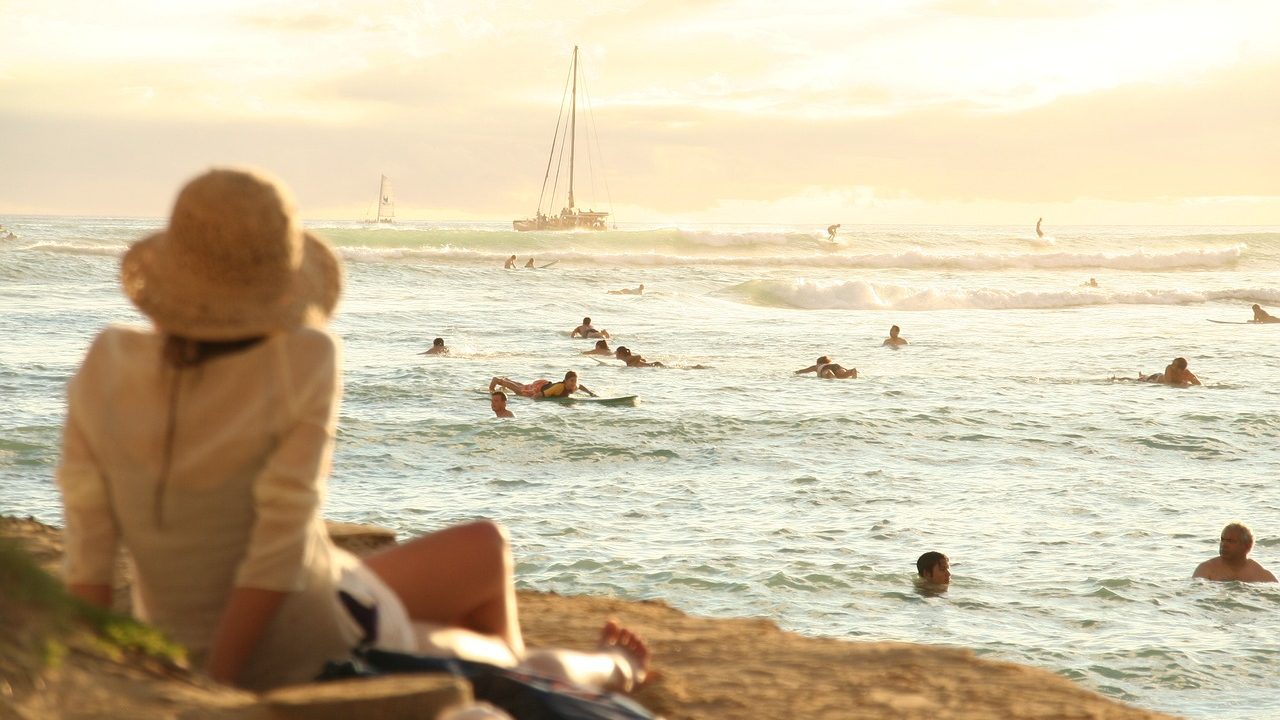Anúncios
Planning a vacation to Hawaii is a dream for many, but how much does a trip to Hawaii cost?Understanding the cost is crucial for planning a great trip to this paradise.
So, this guide provides you an in-depth look at the average expenses involved in a Hawaii trip, including flights, accommodation, food and activities to help you budget effectively.

Flights to Hawaii
Planning a trip to Hawaii starts with understanding the cost of flights. Airfare to Hawaii can vary widely based on several factors, including your departure location, the time of year, and how far in advance you book your tickets.
Average Flight Costs: Generally, round-trip flights to Hawaii can range from $500 to $1,000. Travelers flying from the West Coast of the United States might find lower prices, often around $500 to $700, while those departing from the East Coast or Midwest can expect higher costs, closer to $800 to $1,000.
Peak Seasons: Travel costs tend to spike during peak seasons, such as summer, winter holidays, and spring break. If your schedule is flexible, consider traveling during the off-peak times, like late spring or early fall, to secure lower fares.
Booking Tips:
- Advance Booking: Booking your flight at least three to six months in advance can help you find better deals.
- Flexible Dates: Use fare comparison tools and be flexible with your travel dates. Mid-week flights are often cheaper than weekend flights.
- Airfare Alerts: Sign up for airfare alerts to get notified of price drops and special deals.
Accommodation Costs in Hawaii
Once you’ve booked your flight, the next major expense is accommodation. The cost of lodging in Hawaii varies significantly depending on the island, location, and type of accommodation.
Hotel and Resort Prices: On Oahu, which includes the popular Waikiki Beach area, hotel prices for mid-range accommodations typically range from $200 to $400 per night. Luxury resorts can cost upwards of $500 per night. On other islands like Maui or Kauai, prices can be similar, though sometimes slightly higher due to the more exclusive nature of these destinations.
Alternative Lodging Options:
- Vacation Rentals: Platforms like Airbnb and Vrbo offer a wide range of vacation rentals, from budget-friendly studios to luxurious beachfront homes. Prices for vacation rentals can range from $100 to $300 per night, depending on the property and location.
- Hostels and Budget Hotels: For budget-conscious travelers, hostels and budget hotels are available. Hostel dorm beds might cost around $30 to $60 per night, while budget hotels can range from $100 to $150 per night.
Booking Tips:
- Early Reservations: As with flights, booking your accommodation early can help you secure better rates and availability.
- Package Deals: Look for travel packages that combine flights and accommodation for potential savings.
- Loyalty Programs: Use hotel loyalty programs and credit card points to reduce accommodation costs.
Transportation Costs
When planning a trip to Hawaii, transportation is a significant factor to consider. Given the spread-out nature of the islands, getting around can greatly impact your overall budget.
Car Rentals
Renting a car is often the most convenient option for tourists. It provides flexibility and freedom to explore the islands at your own pace. The average cost of renting a car in Hawaii ranges from $50 to $100 per day, depending on the type of vehicle and the rental company.
Prices can be higher during peak travel seasons, so booking in advance is recommended. Consider looking for rental packages that include unlimited mileage and additional driver options to save on costs.
Public Transportation
Hawaii offers public transportation options, particularly on the island of Oahu, which has an extensive bus system known as TheBus. A single bus ride costs around $2.75, and a day pass is available for $5.50, allowing unlimited rides. While buses are a budget-friendly option, they may not reach all tourist destinations, and travel times can be lengthy.
Ride-Sharing Services
Ride-sharing apps like Uber and Lyft operate in Hawaii and can be a convenient alternative to car rentals, especially for shorter trips or when parking is challenging. The cost varies based on distance and demand, but it can be more economical than renting a car for travelers planning limited travel.
Taxis and Shuttles
Taxis and airport shuttles are available but tend to be more expensive than other options. Airport shuttle services charge approximately $15 to $30 per person for one-way trips to popular hotel areas. Taxis charge metered rates, with an average fare from Honolulu Airport to Waikiki costing around $40.
Food and Dining Expenses
Food is an essential part of the Hawaiian experience, with a rich culinary scene that includes everything from street food to high-end dining.
Average Meal Costs
Dining out in Hawaii can be pricey. On average, a meal at a mid-range restaurant costs between $15 and $30 per person. For a more upscale dining experience, prices can exceed $50 per person. Fast food and casual dining options are available, with meals typically costing around $10 to $15.
Budget-Friendly Tips
- Local Markets: Shopping at local markets and grocery stores can significantly reduce food costs. Farmers’ markets offer fresh produce and local delicacies at reasonable prices.
- Hotel Breakfasts: Many hotels offer complimentary breakfasts. Taking advantage of these can save money on one meal per day.
- Food Trucks: Hawaii’s food truck scene is vibrant and diverse, offering affordable and delicious meals. Popular dishes include poke bowls, shrimp plates, and loco moco.
Dining Options by Island
- Oahu: Known for its diverse dining scene, Oahu offers everything from fine dining in Waikiki to food trucks on the North Shore.
- Maui: Maui’s dining options range from upscale restaurants in Wailea to casual eateries in Lahaina.
- Big Island: The Big Island features farm-to-table dining experiences and local favorites like Kona coffee and macadamia nuts.
- Kauai: Kauai offers a more laid-back dining scene with local fish markets, food trucks, and beachfront restaurants.
Special Diets
Hawaii caters to various dietary needs, including vegetarian, vegan, and gluten-free options. Many restaurants highlight local and organic ingredients, making it easier for health-conscious travelers to find suitable meals.
Activities and Entertainment
When planning your trip to Hawaii, it’s essential to budget for activities and entertainment. The islands offer a diverse range of experiences, from relaxing on pristine beaches to adventurous excursions that can significantly enhance your vacation.
Beach Activities and Water Sports
Hawaii is renowned for its stunning beaches and clear waters, making beach activities a must. Many beach activities are free, such as sunbathing, swimming, and beachcombing. However, more adventurous water sports like snorkeling, scuba diving, and surfing can incur costs. Renting snorkeling gear, for instance, can cost around $10 to $20 per day, while a surfing lesson might set you back $50 to $100 per session.
Hiking and Nature Tours
The islands’ diverse landscapes offer numerous hiking opportunities, from the lush trails of Kauai’s Na Pali Coast to the volcanic terrains of the Big Island. Many hiking trails are free to access, but guided tours, which provide valuable insights and safety, typically cost between $50 and $150 per person.
Cultural Experiences
Immerse yourself in Hawaii’s rich cultural heritage by attending a traditional luau, which often includes dinner, entertainment, and cultural demonstrations. The cost for a luau ranges from $80 to $150 per person. Additionally, visiting historical sites such as Pearl Harbor or the Iolani Palace can provide educational experiences, with entry fees ranging from $10 to $30.
Outdoor Adventures
For thrill-seekers, Hawaii offers various outdoor adventures, including zip-lining, ATV tours, and helicopter rides. These activities can be more expensive, with prices ranging from $150 to $400 per person, but they offer unique perspectives of the islands’ natural beauty.
Special Discounts and Packages
To save on costs, look for special discounts and package deals. Many tour companies offer bundle deals that combine multiple activities at a reduced rate. Additionally, booking activities in advance online can sometimes provide significant savings.
Additional Expenses
Through all this Hawaii trip cost, it’s crucial to consider additional expenses beyond the primary costs of flights, accommodation, food, and activities.
Travel Insurance
Investing in travel insurance is highly recommended to protect yourself against unforeseen circumstances such as trip cancellations, medical emergencies, or lost luggage. The cost of travel insurance typically ranges from 5% to 10% of your total trip cost, depending on the coverage and your travel needs.
Souvenirs and Shopping
Hawaii is famous for its unique souvenirs, including Hawaiian shirts, leis, macadamia nuts, and locally made crafts. Budgeting for these items is essential if you plan to bring back mementos or gifts for loved ones. The cost of souvenirs can vary widely, but setting aside $100 to $200 should cover most typical purchases.
Tips and Gratuities
This cost in a Hawaii trip is crucial because, as in the rest of the United States, tipping is customary and expected for many services, including dining, housekeeping, and guided tours. Standard tipping rates are around 15% to 20% for restaurant bills and $1 to $2 per bag for hotel bellhops. Ensure you budget for these additional expenses to avoid any surprises.
Transportation Costs
While car rental is often the most convenient way to explore the islands, other transportation costs can add up. These include gas, parking fees, and any additional insurance you may choose to purchase. Public transportation and ride-sharing services are alternatives, but they might limit your flexibility.
Health and Safety Supplies
Given the tropical climate and active outdoor lifestyle, it’s wise to budget for health and safety supplies such as sunscreen, insect repellent, and first aid items. These items can be more expensive on the islands than on the mainland, so consider bringing them from home if possible.


